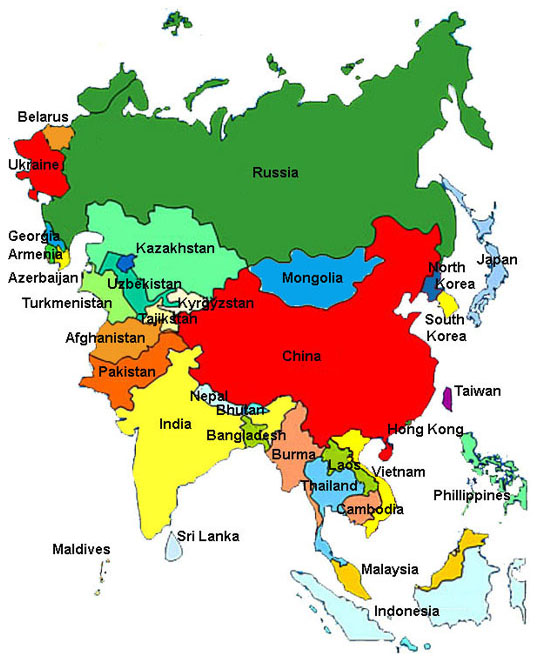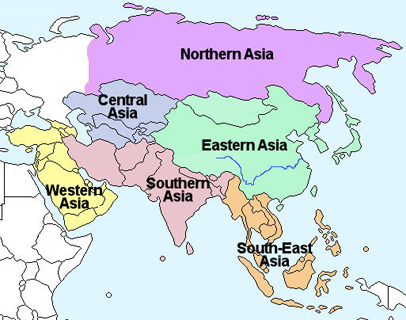
Grade 7 | Lesson 8
Dean of Students: dean@theschools.com
Tech Services: tech@theschools.com

Grade 7 | Lesson 8
Dean of Students: dean@theschools.com
Tech Services: tech@theschools.com
Social Sciences
Lesson Overview
Geography
• Asia
![]()
Geography
Asia
Asia is the world’s largest continent,17,139,000 sq mi (44,390,000 sq km), with about 3.3 billion people, nearly three fifths of the world’s total population.

Asia’s border with Europe lies approximately along the Urals, the Ural River, the Caspian Sea, the Caucasus, the Black Sea, the Bosporus and Dardanelles straits, and the Aegean Sea. The connection of Asia with Africa is broken only by the Suez Canal between the Mediterranean Sea and the Red Sea. In the far northeast of Asia , Siberia is separated from North America by the Bering Strait. The continent of Asia is washed on the South by the Gulf of Aden, the Arabian Sea, and the Bay of Bengal; on the East by the South China Sea, East China Sea, Yellow Sea, Sea of Japan, Sea of Okhotsk, and Bering Sea; and on the North by the Arctic Ocean.
Asia can be divided into six regions, each possessing distinctive physical, cultural, economic, and political characteristics:
Southwest Asia (Iran; Turkey, in Asia Minor; and the nations of the Fertile Crescent and the Arabian peninsula or Arabia), long a strategic crossroad, is characterized by an arid climate and irrigated agriculture, great petroleum reserves, and the predominance of Islam.
South Asia ( Afghanistan and the nations of the Indian subcontinent) is isolated from the rest of Asia by great mountain barriers.
Southeast Asia (the nations of the southeastern peninsula and the Malay Archipelago ) is characterized by monsoon climate, maritime orientation, the fusion of Indian and Chinese cultures, and a great diversity of ethnic groups, languages, religions, and politics. 
East Asia ( China , Mongolia , Korea , and the islands of Taiwan and Japan ) is located in the mid-latitudes on the Pacific Ocean , and is characterized by cultures strongly influenced by civilizations of the Huang He and Chang (Yangtze) river systems. It forms the most industrialized region of Asia .
Russian Asia (in the northern third of the continent) consists of the vast region of Siberia and the Russian Far East.
In the center of the continent is Central Asia, formed of a set of independent former republics of the Soviet Union. This region is characterized by desert conditions and irrigated agriculture, with ancient traditions of nomadic herding.
The distribution of Asia ’s huge population is governed by climate and topography, with the monsoons and the fertile alluvial plains determining the areas of greatest density. Such are the Ganges plains of India and the Chang (Yangtze) and northern plains of China , the small alluvial plains of Japan, and the fertile volcanic soils of the Malay Archipelago. Urbanization is greatest in the industrialized regions of Japan, Korea, and Taiwan, but huge urban centers are to be found throughout the continent. 
Almost two thirds of Asia ’s indigenous population is of Mongolic stock. Major religions are Hinduism (in India); Theravada Buddhism (in Sri Lanka, Myanmar, Thailand, Cambodia, Vietnam, and Laos); Lamaism, or Tibetan Buddhism (in Mongolia and China, particularly Tibet); East Asian Buddhism (in China and Korea, mixed with Confucianism, shamanism, and Taoism; in Japan mixed with Shinto and Confucianism); Islam (in SW and S Asia, W central Asia, and Indonesia); and Catholicism (in the Philippines, East Timor, and Vietnam).
Research It!
What were the earliest civilizations in Asia? Were they more advanced then their western counterparts?